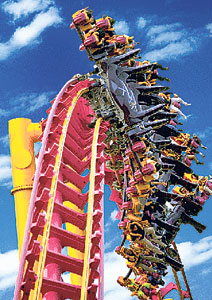If you're studying physics, there are few more exhilarating
classrooms than a roller coaster. Roller coasters are driven almost entirely by basic inertial, gravitational and centripetal forces, all used to create a great ride.
In recent years,
designers have introduced coasters that have you lying flat against the train car so you feel as if you are flying, and coasters that shoot you down long stretches of
spiralled track. "Fourth dimension" coasters spin or rotate your seat as the ride twists, turns and free-falls.
Roller coasters have a long,
fascinating
history. The direct ancestors of roller coasters were monumental ice slides – long, steep wooden slides covered in ice, some as high as 70 feet – that were
popular in Russia in the 16th and 17th centuries. Riders shot down the slope in sleds made out of wood or blocks of ice, crash-landing in a sand pile.
A roller coaster's energy is constantly changing between potential and kinetic energy. When the coaster ascends one of the smaller hills that
follows the initial lift hill, its kinetic
energy changes back to potential energy. In this way, the course of the track is constantly converting energy from kinetic to potential and back again.
Free fall has a strange effect on your body because your body is not completely solid – it is composed of many loosely connected parts. When your body is accelerated, each part of your body is accelerated individually. The seat pushes on your back, the muscles in your back push on some organs and those organs push on other organs. This is why you feel the ride with your whole body. Everything inside is being pushed around.
Normally, all the parts of your body are pushing on each other because of the constant force of gravity. But in the "free-fall" state of plummeting down a hill, there is hardly any net force acting on you. In this case, the various pieces of your body are not pushing on each other as much. They are all, essentially, weightless, each falling individually inside your body.
This is what gives you that unique sinking feeling in your stomach – your stomach is suddenly very light because there is less force pushing on it. The same thing happens when you drive down a dip in the road in your car or descend in an elevator moving at high speed, but neither is as much fun as being on a rollercoaster! |


